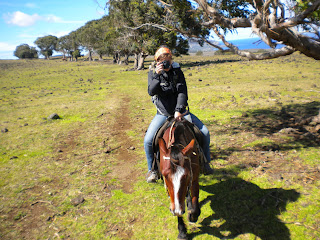La propiedad del guía. Our guide's property.
One of our guides. Interesting fellow. Didn't speak much.
I was taking blind pictures all day and happened to snatch this one of Katie!
Después de dos horas, paramos a una cueva con petroglifos. Ya había empezado sentir los efectos de montar un caballo. Montamos una hora más y luego paramos para almorzar. Bueno, primero los guías tenían que pescar y cocinar los peces. Como dije, una aventura.
The cave with petrolyphs.
Lauren and the crew
My trusty steed, Elle.
Our guides catching fish.
It's an okay lunch spot.
After sunrise, we returned to the hostel and our horseback ride guide picked us up. This day was an unforgettable adventure/experience. Our guides were legit Rapa Nui. They had never left the island, took care of their horses all day and sometimes gave tours like ours. We rode along the northern coast of the island. The scenery was incredible for the seven-ish hours of our tour. On our left was the unbelievably blue sea and on our right was the largest volcano on the island.
Yep
After two hours, we stopped at a cave to see petroglyphs. I had already started to feel the effects of riding a horse. We rode for an hour more and then stopped to have lunch. Well, our guides had to catch lunch first and then cook it. As I said, an adventure.
Beach!
The fish had a great flavor and couldn't have been fresher but I still couldn't eat them. I chose the meat which (of course) came from a ranch we had passed about 30 minutes before. (Happy cows make delicious meat) Another two hours on horseback and we arrived at our destination: a beautiful beach. I bought some jewelry from a lady on the beach and had a glass of guayaba juice (awesome) sitting on the sand (we almost couldn't walk). What a great day :)
Unable to walk anymore
Don't forget the moai!




























































